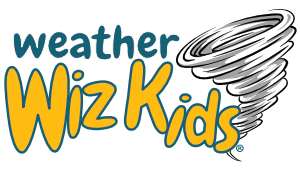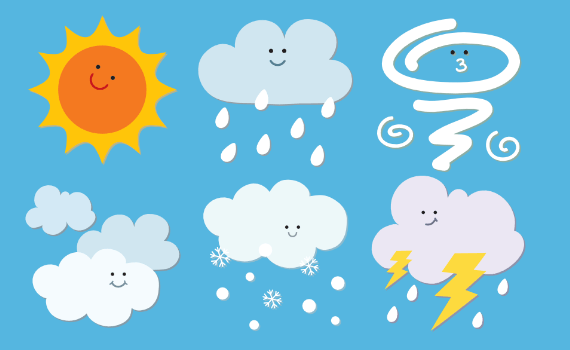
Weather
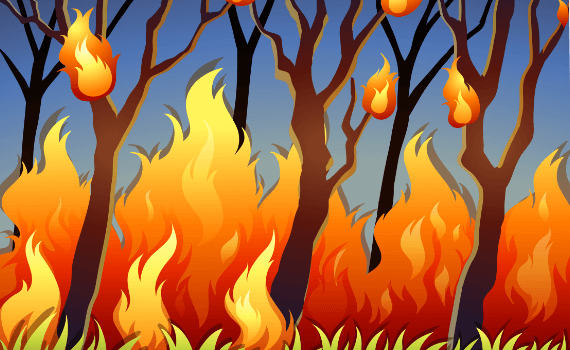
Natural Disasters

Experiments
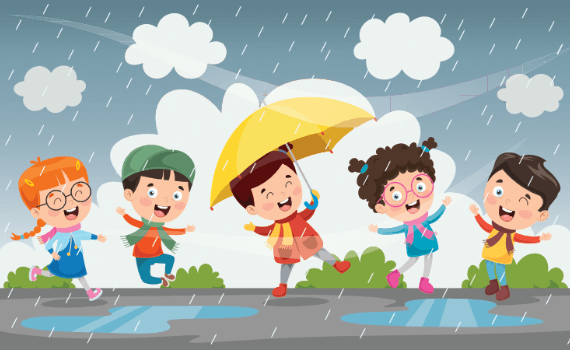
Kid's Zone
Tsunami
What is a tsunami?
A tsunami is a large ocean wave usually caused by an underwater earthquake or a volcanic explosion. Tsunamis are NOT tidal waves. Tidal waves are caused by the forces of the moon, sun, and planets upon the tides, as well as the wind as it moves over the water. With typical waves, water flows in circles, but with a tsunami, water flows straight. This is why tsunamis cause so much damage!
How are tsunamis generated?
Tsunamis are generated by any large, impulsive displacement of the sea level. The most common cause of a tsunami is sea floor uplift associated with an earthquake. Tsunamis are also triggered by landslides into or under the water surface, and can be generated by volcanic activity and meteorite impacts.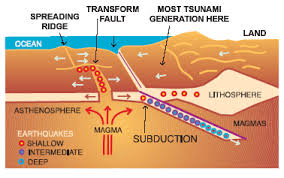
How often do tsunamis occur?
On the average, two tsunamis occur per year throughout the world which inflict damage near the source. Approximately every 15 years a destructive, ocean-wide tsunami occurs.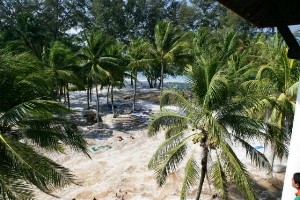
Can strike-slip (horizontal motion) earthquakes trigger tsunamis?
Yes, approximately 10-15% of damaging tsunamis are triggered by strike-slip earthquakes. This type of earthquake is less likely to trigger a tsunami than one with vertical motion. The waves are likely generated by associated landslides or motion of a sloping bathymetric feature. Tsunamis generated by strike-slip earthquakes normally affect regions near the source only.
What does the word “tsunami” mean?
Tsunami (soo-NAH-mee) is a Japanese word meaning harbor wave.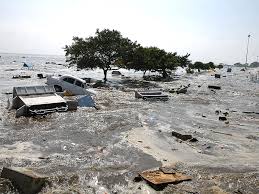
How fast do tsunamis travel?
Tsunami velocity depends on the depth of water through which it travels. Velocity equals the square root of the product of the water depth times the acceleration of gravity. Tsunamis travel approximately 475 mph in 15,000 feet of water. In 100 feet of water the velocity drops to about 40 mph.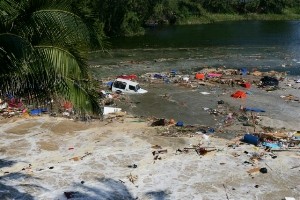
Did you know…A tsunami travels from the central Aleutian Islands to Hawaii in about 5 hours and to California in about 6 hours, or from the Portugal coast to North Carolina in about 8.5 hours.
How big is a tsunami?
Tsunamis range in size from inches to over a hundred feet. In deep water (greater than 600 feet), tsunamis are rarely over 3 feet and are not normally noticed by ships due to their long period or time between crests. As tsunamis propagate into shallow water, the wave height can increase by over 10 times. Tsunami heights vary greatly along a coast. The waves can be amplified by shoreline and sea floor features. A large tsunami can flood low-lying coastal land over a mile from the coast.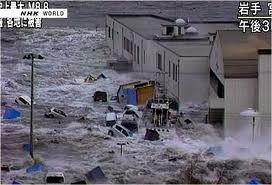
What does a tsunami look like when it reaches shore?
Normally, a tsunami appears as a rapidly advancing or receding tide. In some cases, a wall of water or series of breaking waves may form.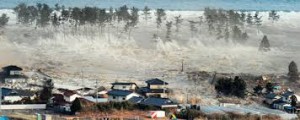
How is a tsunami different from a wind-generated wave?
Wind-generated waves usually have periods or time between crests between 5 and 15 seconds. Tsunami periods normally range from 5 to 60 minutes. Also, wind-generated waves break as they shoal and lose energy offshore. Tsunamis act more like a flooding wave. A twenty foot tsunami is a twenty foot rise in sea level.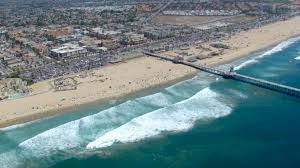
What are nature’s signs that a tsunami may be imminent?
There are a few signs like hard ground shaking for 20+ seconds near the coast or a sudden sea level withdrawal. Tsunamis may be accompanied by loud, booming noises.
Can earthquakes and tsunamis be predicted?
No, earthquakes cannot be predicted. Once an earthquake has occurred, the arrival time of a tsunami, if generated, can be determined accurately. There is not normally enough time to accurately predict tsunami heights near the source. Away from the source, tsunami wave heights can be estimated based on mathematical tsunami models and observed wave heights.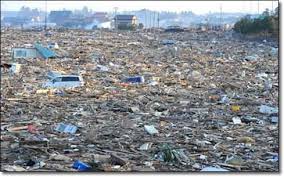
Aerial video of the tsunami that devastated Japan on March 11, 2011.
Click Here to see an animation of an earthquake and the resulting tsunami. It’s great for kids, because they get to see how it actually happens!
What are some of the most damaging tsunamis?
- Japan: Major tsunami in 2011 generated in the Pacific Ocean.
- Asia: Asian tsunami in 2004 generated in the Indian Ocean.
- Alaska: Major tsunamis were generated along the Alaskan coast in 1946, 1957, 1958, 1964, and 1965. Many other locally generated tsunamis occurred prior to those dates.
- US/Canada West Coast: Tsunamis were generated locally in 1812, 1873, 1878, 1927, 1930, 1946 and 1949. The west coast was also impacted by tsunamis generated in other regions in 1877, 1946, 1952, 1957, 1960, 1964, 1975, 2006, and 2010.
- US/Canada Atlantic Coast: Tsunamis were recorded in 1755, 1884, 1886, and 1929.
- Puerto Rico and the Virgin Islands experienced damaging tsunamis in 1867 and 1918.
Click Here for the NOAA/National Geophysical Data Center tsunami catalog.
TSUNAMI WARNING- A tsunami warning indicates that a tsunami may be imminent and that coastal locations in the warned area should prepare for flooding. The initial warning is typically based solely on seismic information. After the tsunami is recorded on sea level gages, the warning will be cancelled, restricted, expanded, or downgraded to an advisory. Warnings indicate that flooding up to the maximum expected limit is possible and residents should follow their local emergency management instructions. Warnings are issued when the earthquake information or tsunami forecasts indicate that a wave over 1 meter in amplitude is expected, possible, or ongoing.
TSUNAMI ADVISORY- A tsunami advisory indicates a tsunami which may produce strong currents and is dangerous to those in or very near the water is expected. Large inundations are not expected in areas under advisory status. Advisories will be cancelled, extended, or upgraded to a warning depending on the event severity. Advisories are issued when the tsunami forecast is in the range of 0.3 to 1 meter, or an observed tsunami is in the range of 0.5 to 1.0 meters.
TSUNAMI WATCH- A tsunami watch is an early alert issued to areas which may later be impacted by a tsunami. Tsunami impact is normally at least three hours away for regions within a tsunami watch. The watch will either be upgraded to a warning or advisory in subsequent messages or cancelled depending on the severity of the tsunami. People within a watch area should stay alert for further information regarding tsunami threat.
CREST– The top of a wave.
FJORD– A narrow sea inlet between cliffs or steep slopes.
SURGE– A large wave or billow.
TROUGH– The lowest point between waves.
Click Here to get the latest tsunami warning information from the NWS.
PLAN FOR A TSUNAMI: Have a disaster plan. Know whether you’re at risk for danger. Plan an evacuation route. Prepare a disaster supplies kit for your home and car. Include a first aid kit, canned food and a can opener, bottled water, battery-operated radio, flashlight, protective clothing and written instructions on how to turn off electricity, gas, and water.
DURING A TSUNAMI: Follow the instructions issued by local authorities. You will probably want to evacuate immediately. Get to higher ground and as far inland as you can.
AFTER A TSUNAMI: Help injured or trapped people. Stay out of a building if water remains around it. Tsunami waters can cause buildings to sink, floors to crack, or walls to collapse. When re-entering homes, use extreme caution. Check for gas leaks. Open windows and doors to help dry things out. Look for fire hazards.
Lesson Plan: Here is a great lesson plan on learning about tsunamis. Note: This is a PDF file, so you need to have Adobe Acrobat Reader.
Lesson Plan: Here is a great lesson plan on tracking a tsunami.
Lesson Plan: Here is a great lesson plan on tsunamis and how they devastating effects they may cause in the world.
